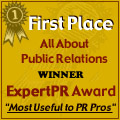|
by
Steve Jursa
3Point
Communications
 In
recent years an enormous amount of content has been In
recent years an enormous amount of content has been
generated around the
topic of “content.”
The web and blogosphere are
full of discussions around content marketing, content creation, content
optimization, content distribution, content performance, media content,
corporate journalism and on and on.
Today, if you want to be successful in your marketing and communications
efforts, you have to have a “content” plan; and for good reason. No
longer can your company produce ad copy or press releases in isolation and
then push them out to customers because there is simply too much
information for customers to effectively absorb.
If information comes at them
unsolicited, customers either block it out intentionally, or miss it
because it gets lost in the sheer volume of noise.
If you want to reach your customers effectively you have to engage them in
an ongoing dialogue. Your customers have to want information from you, and
the only way they’re going to do that is if you provide them with a
steady diet of thoughtful, entertaining and useful information.
Essentially, you have to start
thinking of your company as a publishing company.
The good news is that your company has a wealth of content just waiting to
be shared. Just think of all the PowerPoint presentations, plans,
proposals, internal newsletters, sales literature, memos, videos and other
materials you have inside your company.
This myriad of corporate
information can be turned into valuable content for your customers. But
remember, you can’t just take this information, put a fresh coat of
paint on it, and expect it to resonate with your customers.
There are a number of factors you should consider when producing content
for your customers.
Here are but a few:
1. What are your
company’s business objectives? Does the content you produce align
with your business objectives? Be specific because it will help you
create better content. Increasing sales in Europe is too vague to be a
useful business objective for content generation. Rather, try to refine
it; increase sales in Germany, France and the Benelux countries by X%
during the next year by selling our ABC software solution into the
financial services market. The more detail you can include in your
business objectives the better content you will produce, and the better
you will be able to measure the success of your content-centered
communications program.
2. Who, specifically, are you trying to reach with your content?
While the temptation may be to say “whoever will buy my product,” if
you’re going to maximize the impact of the content you generate you
will need to be very specific about the people you’re trying to reach.
For instance, you might narrow it to include CIOs and senior IT
professionals at banks, insurance companies, brokerage firms and other
financial institutions in your targeted European countries.
3. What do your customers need? If you can clearly define the
needs of your customers, then you can develop content that will be
meaningful to them. Your customers will respond favorably to your
content, and come back to you looking for more, if you can, for example,
help them identify key problems they may face in the future and how to
solve them. If your content becomes a key factor in their decision
making process, then your company will be viewed as a trusted business
partner and not just a supplier or vendor.
4. What type of content does your target audience want? This is
vitally important in the creation of customer-relevant content. If your
customers want to read in-depth technical information about how you
solved a problem for another company in their industry, developing a
light-hearted video might not be the best choice as a delivery
mechanism. Content comes in all shapes and sizes, from white papers and
technical documents to video and podcasts to eBooks and online slide
presentations, and covers an infinite number of topics. Therefore, it is
critical to align the type of content you create, and the information it
contains, with what your customers are looking for.
5. Where do your customers go to find their information? Some
people love Twitter. Others are addicted to Facebook. Some are YouTube
junkies. Many prefer email and web sites. Still others, believe it or
not, still read newspapers and magazines. If you’re going to
effectively engage your customers in a meaningful dialogue, you need to
present your content where they typically look for information.
Otherwise, they'll never see your brilliant content.
These five factors are by no
means all you need to know to develop a comprehensive content-centered
communications program, but they are integral to any such plan.
Steve Jursa
is a partner at 3Point
Communications, a global
communications consulting firm specializing is creating
content-centered public relations campaigns for technology brands.
Contact him at sjursa@3pointcommunications.com
More
Articles | Submit
Your Article | PR
Subjects
About
Public Relations Homepage
Contact Us
|



